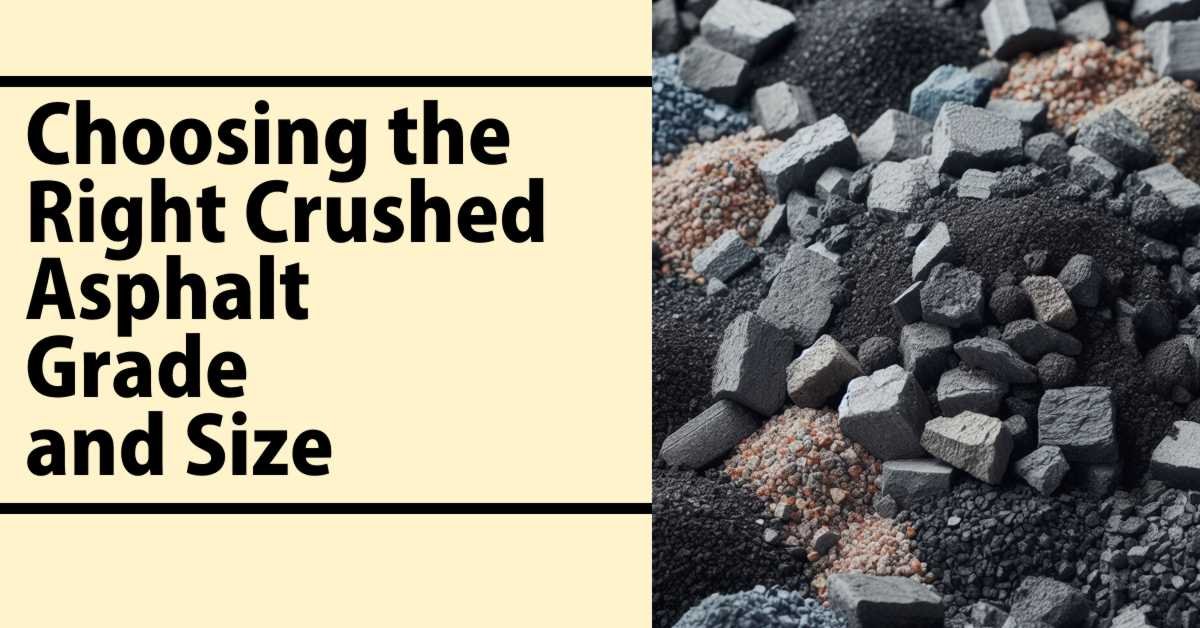Asphalt millings, also known as recycled asphalt pavement (RAP), offer a cost-effective and environmentally friendly alternative for driveway construction. These crushed remnants of old asphalt roads and surfaces can be repurposed to create durable and low-maintenance driveways. However, choosing the right grade and size of asphalt millings is crucial to ensure optimal performance and longevity for your driveway project.
Understanding Asphalt Millings
Recycled asphalt comes from milling or grinding old surfaces of the road during repairs or reconstruction. They are a blend of asphalt binder and materials like crushed rocks, gravel, or sand.

Using asphalt millings for driveways offers several benefits:
Cost-effective:
Asphalt millings are typically less expensive than virgin asphalt materials, making them an affordable option for driveway construction.
Environmental sustainability:
By repurposing existing asphalt materials, asphalt millings reduce the need for new resources and minimize waste.
Durability:
When properly installed, asphalt millings can provide a sturdy and long-lasting driveway surface.
Low maintenance:
Asphalt milling driveways require relatively low maintenance compared to other driveway materials.
Grades of Crushed Asphalt
Asphalt milling is available in different grades, which are determined by the size and composition of the crushed material. The most common grades used for driveways are:
Fine Millings:
These smaller particles, ranging from dust to 3/8 inch in size, are primarily used as a surface layer or topping for driveways.
Coarse Millings:
Larger particles, typically ranging from 1/2 inch to 1 inch in size, are ideal for the base layer or sub-base of a driveway.
Mixed Millings:
A combination of fine and coarse millings, offering a balance between stability and drainage.
When choosing a grade, consider factors such as the anticipated traffic load, desired surface smoothness, and drainage requirements of your driveway.
Sizes of Crushed Asphalt
In addition to grades, asphalt millings are available in various sizes, ranging from fine dust to larger chunks. The size of the crushed asphalt particles can significantly impact the performance and characteristics of your driveway.
Smaller sizes, such as fine millings or 3/8 inch particles, are often used as a surface layer or topping. They provide a smoother, more compact surface ideal for lighter traffic.
Larger sizes, like 1-inch or 2-inch particles, are better suited for base layers or sub-bases. These coarser materials offer better load-bearing capacity and drainage, making them suitable for driveways with heavier traffic or areas prone to water accumulation.
How to Choose the Right Grade and Size
To select the appropriate grade and size of asphalt millings for your driveway project, consider the following factors:
Traffic Load:
Driveways with heavier traffic or frequent use by large vehicles may require coarser millings or a thicker base layer to withstand the increased load.
Weather Conditions:
In areas with frequent rainfall or harsh winters, larger millings can improve drainage and prevent water accumulation, reducing the risk of potholes and surface degradation.
Desired Surface Smoothness:
If a smoother surface is preferred, fine millings or a combination of fine and coarse millings may be the better choice.
Budget:
While asphalt millings are generally cost-effective, finer grades and larger sizes may have varying costs, affecting your overall budget.
It’s essential to consult with experienced professionals who can assess your specific driveway needs and recommend the most suitable grade and size of asphalt millings.
How to create a Driveway from Asphalt Millings
Proper installation is crucial to ensure the longevity and performance of your asphalt milling driveway. Here are some essential tips:
- Prepare the Base: Start with a well-compacted and graded base layer, ensuring proper drainage and stability.
- Layer Thickness: For the base layer, aim for a compacted thickness of 4 to 8 inches, depending on the anticipated traffic load. The surface layer should be 2 to 4 inches thick.
- Compaction: Compact each layer thoroughly using a mechanical roller or a plate compactor to achieve the desired density and stability.
- Maintenance: Regular maintenance, such as grading, topping with fresh millings, and addressing any potholes or drainage issues, can help extend the lifespan of your driveway.
Useful Resources:
- National Asphalt Pavement Association (NAPA) – NAPA provides resources and guidelines for asphalt pavement construction, including information on crushed asphalt specifications.
- American Association of State Highway and Transportation Officials (AASHTO) – AASHTO sets standards for highway and transportation infrastructure in the United States, including specifications for crushed asphalt materials.
- Federal Highway Administration (FHWA) – FHWA offers technical guidance and resources for highway engineering and construction, which may include information on crushed asphalt usage and specifications.
- ASTM International – ASTM develops and publishes technical standards for various materials used in construction, including crushed asphalt. Their standards provide guidelines for testing and quality assurance.
